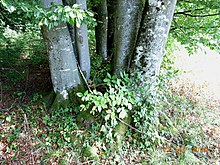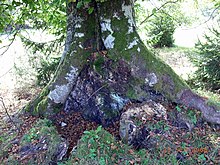Hat tree
A Hutebaum even Weidbaum , is related to intensive grazing ( hat incurred) tree .
Linguistic aspect
The word Hute (Hude) for pasture in general or just for a certain form of pasture has disappeared from everyday language. The term no longer appears in the Duden dictionary from 1996. The word compounds with hats suffered a similar fate, but they are more persistent than the root word. 1996 in the Duden there is still Hutweide with the addition of community pasture , to which the cattle are driven daily , in Knaur 1973 Hutung , Hutweide, with the addition for low-quality pasture . In Pfohl (1911), the word hat in the importance of grazing rights listed. In the German-Hungarian dictionary by Előd Halász (1994), which is excellent for its completeness, Huter can be found as a guardian or cattle keeper, hat money as wages for the shepherd, hat justice as hat right, hating, hat forest and hat pasture. However, the term hat tree is also missing here.
Although spruce, maple, ash, linden and elm are also given as hat trees, the only word combinations with tree species are hat oak, hat beech , willow beech and willow beech. These expressions have been preserved as technical terms on the one hand and regionally on the other, sometimes with a tendency towards proper names for very specific trees. It is not surprising that there are regional differences in linguistic usage. Robert Gradmann (Plant Life of the Swabian Alb) used z. B. the term Weidbuche, but not Hutebuche, in the Rhön however the term Hutebaum seems to be common.
To round off the language problem, the register by H. Küster (History of the Forest) states that there Hudewald and Hutwald on more than 13 pages, Hudeeiche on 6 pages, but Huteeiche never, Hudebuche on one page and Willow beech on three, and Weidbaum on one Page.
Meaning variance

Since the term hat is not unique, one can expect that hat tree will also be used in different meanings. These can usually only be inferred from the context, since they are not given in the form of a definition. The following meanings can be found for Hutebaum:
- Mighty solitary tree, the relic of an original forest that was destroyed by grazing. Typical for this linguistic context is the phrase old hat tree .
- Partly synonymous with mast tree, to which the cattle were driven to look for fodder, especially pigs for beech trees because of the beechnuts , and oaks for the acorns. This is probably the reason why the terms hat oak and hat beech exist, but not z. B. Hutelinde. Such trees do not have to be solitary trees, but can very well be in the (Hute) forest or on the edge of the forest.
- Tree that is characterized by a special growth form. It is the result of several trees growing together that now form a common trunk (polykorm). There are different possibilities for this. Such trees can have arisen from stick rashes from a monocormic trunk, or when grazing under the protection of scrub and the like. a. come up and grown into a tree for lack of space. These trees do not have to stand alone either, on the contrary, they are now often grown in spruce forests. In addition, these trees are still growing today. The beech tree shown in Fig. 2 is certainly a relatively young tree and Fig. 4 shows an initial stage of a polycorrhoidal structure.
Biological aspect
In certain areas, in the interests of species and biotope protection, the aim is to prevent the emergence of the forest; in other areas, however, the problem of the destruction of the tree population through intensive grazing is in view. In both cases, knowledge of willow trees is twofold.
- The hat tree is a historical document, a relic and a witness of an old form of pasture that withstood the pressure of overgrazing (gnawing of the trunk and the lower branches, scraping on the trunk, overfertilization by the amount of feces and urine, soil compaction and damage by the hooves of the grazing animals) Has. The question arises as to which trees have the best chance of survival or are suitable for a certain form of pasture.
- The hat tree is a tree that succeeded or succeeds in coming up in grazed area. Which grazing animals (goats, sheep, pigs, cattle) are involved naturally plays a role. Gradmann explains that on sheep pastures, trees can come up under the protection of the juniper , since the sheep avoid it. It is the shepherd's job to remove the juniper so that the willow does not overgrow. Elsewhere, hawthorn , sloe and other thorn bushes are cited as opportunities for the young plants. It is also conceivable that, for. B. in the protection of large boulders or in karst holes, individual seeds can successfully develop into young plants. The top shoots of the young plants are then grazed from above and these grow more and more in width (cow bush). After all, the bushes are so expansive that the central area can no longer be bitten. The bushes can grow up there, central tree trunks can grow together, peripheral ones tend to die off.
Hutebaum natural monument
Hat trees have a large trunk, a spreading crown and are usually old. In doing so, they attract attention, especially when they are exposed. Often they also document local history.
The cultivation of the coppice forest with simultaneous forest pasture encouraged the emergence of hat trees; today they are rare relics and often marked and protected as natural monuments.
See also
literature
- Duden The German spelling ISBN 3-411-02871-8
- R. Gradmann: Plant life in the Swabian Alb W. Kohlhammer Stuttgart 1950
- E. Halász: German-Hungarian Dictionary Akadémiai Kiadó Budapest 1994 ISBN 963-05-6647-8
- Knaur's spelling Droemer Knaur ISBN 3-426-03330-5
- Hansjörg Küster : History of the forest CH Beck Verlag 2003 ISBN 3-406-50279-2
- Ernst Pfohl: New dictionary of the French and German language Brockhaus Leipzig 1911
Web links
- plenum-rt.de: Beutenlay Münsingen. (PDF file; 2.65 MB) Archived from the original on September 28, 2007 ; Retrieved August 12, 2013 .







